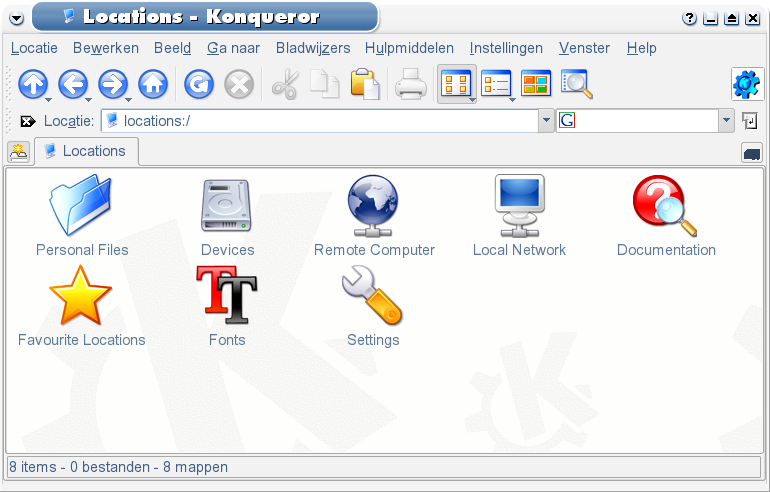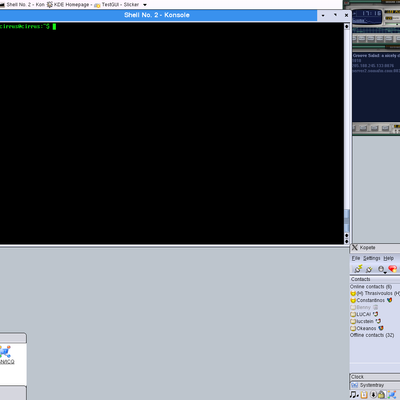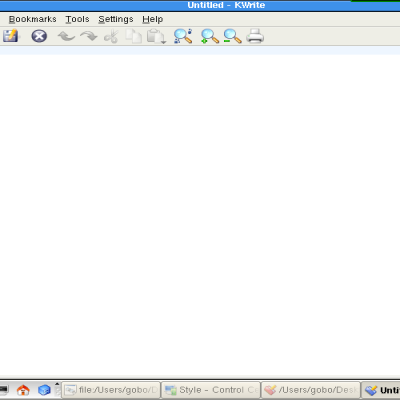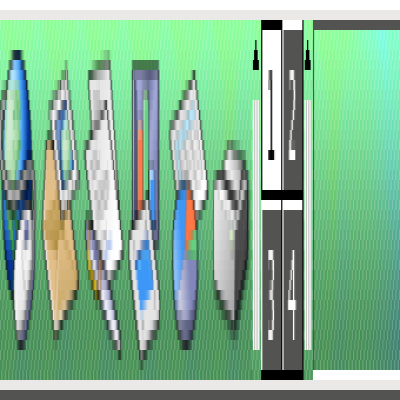This proposal attempts to make these KIO slaves accessible by adding a special KIO Slave called the locations slave. This locations slave is accessible by typing 'locations:/' in the location bar. It offers access to some of the most important available KIO slaves and presents them in a well organized directory structure.
The screenshots show what it could look like to browse the locations slave. Note that the user's home directory is one of the available locations.
Ideally, the locations KIO slave should replace 'file:/home/user' as the default default location of Konqueror's file browsing profile. The home directory will be one click away, but so are many other powerful KIO slaves..
There is no code, it's just a proposal.



























Ratings & Comments
30 Comments
Hi, i think this will not be a help for newbies to understand *nix system architecture. The '/' should stay associated with the root system, nothing else imho. For accesing kio slave there is the konqui side bar wich is there whan u need it... And it's looks too much like a ripp of microsoft windows "my computer" interface => i mean like a "toy interface". Well just my opinion ... But before anything is an idea...
Ok, I know that support it's great but. Turn on the side bar, select serives, find audiocd:// fonts:// print:// bluetooth:// reliesa will do fish:// smb:// telnet:// ssh:// and probably ftp and http man:/ info:// etc.. are still missing, but help should be under help zip:/ etc.. are already intergrated view the file browser. The one missing link is, settings:/ which should be on the desktop.
Hi, This already exists in Turkix, it's called kiostart. You can have a look at it on http://www.turkix.org You can reach its source codes from http://cvsweb.turkix.org
Doesn't take a hall full of usability experts to see this is a good idea overall - something that the immensely powerfull yet mostly unknown KIO Slaves actually *need* in my opinion. But just to point this out directly: Making "locations:/" default instead of home is a bad bad thing. "normal users" (those who would not and should not need to know how to change the default back to "file:/home/user") will have to (read: should) work inside their home directory 90% of the time they open their "File Manager". That said there should be a easily viewable and accessible icon on the desktop saying something like "Locations" or "Start Here" (oh.. that's another DE ;)).
Well, let's talk about truly KDE beginners, I mean, truly *nix beginners. They don't have a clue of what exactly home is for. So a generical starting location could be easily this new locations:/, with another "My files" placed by default on the desktop (and/or in the kicker)
Ok, but those "true beginners" won't be just that forever - even the slowest learner around will eventually become a more andvanced user over time and such a change is just too unusefull for anyone with the slightest idea of what "home" actually might mean, and that this IS the place to be on your filesystem... and it's not that hard to guess if you ask me. Seriously, home beeing the start point for... well, everything makes it even more understandable to new users. What else? A big fat STORE YOUR STUFF HERE sticker? I don't think that's needed. Moving away from that only stirrs confusion as to why people shouldn't have all their data messed around their whole FS.
Might be worth taking a look at http://bugs.kde.org/show_bug.cgi?id=94865 and http://bugs.kde.org/show_bug.cgi?id=94858 I agree, the default should open to the user's home directory, but at the same time the user should be able to discover the network protocols by having the abilty to add them to their tree-view. Konqueror should be smart enough to include network protocols that are already in use (for example, Samba or NFS shares that are already mounted), and at the same time give the user the ability to add new protocols.
Might be worth taking a look at http://bugs.kde.org/show_bug.cgi?id=94865 and http://bugs.kde.org/show_bug.cgi?id=94858 I agree, the default should open to the user's home directory, but at the same time the user should be able to discover the network protocols by having the abilty to add them to their tree-view. Konqueror should be smart enough to include network protocols that are already in use (for example, Samba or NFS shares that are already mounted), and at the same time give the user the ability to add new protocols.
Hi, I appreciate your work (not only this, but also the others) and I hope you all know that this is not against this or other entry or the person who created it (Dik in this case). But there is one thing that makes me (and not only) think that there is some problem with this site. The problem is with the rating system and with categories. It's really strange that entries that are not code appear on the kde-apps.org and even stranger that an entry without code or which is basicly a set of patches reaches the top positions in the matter of days. I can understand that they are popular and they are good ideas, but they are not real applications and it just breaks the credibility of such "highest rated" list when you see that it's rated higher than big and highly appreciated applications like K3B, Krusader or Quanta. Yes, I'm biased, but I don't write this because Quanta falls down one place or two, as I know that the user base is stable and appreciates is, but because in the current case nobody can take such a list seriously. In some cases if the patches get integrated in the applications (or in the KDE base/libs), the entry will be outdated. If the ideas doesn't materialize, they get outdated. If they are and become patches or integrated in applications, they are outdated. But the rating remains and will just pollute the list. So my idea would be some kind of reforming of the top items: - new entries get some kind of penalty regarding the rating - old entries without downloads or new ratings will also get some penalty - some categories should not appear there Nobody has to follow my ideas, maybe I'm completely wrong, but whatever, I had to write down this. ;-) Andras
Well, but there's no other site with such an exposure. KDE-apps is, as now, the best way to get opinions by real KDE users, not only by KDE power-users that read KDE wikis or follow some KDE-devel mailing list or regulary look at bugs.kde.org. So, until things changed, it works this way. And anyway all these kinds of apps fall down "KDE improvement", which is a different catagory from Quanta one, even if Quanta IS a KDE improvement :)
Yes, you're right. The rating system is not really good. Though it's kind of funny to become the second most popular submit in history in a matter of days.. :D I posted this thing exclusively on kde-look.org, because there's no code. Yet, it shows up at kde-apps.org. What's going on here??
...thanks Kurt, I did read your page too late ;-) . You already have had the same idea - really great ;-) . Greetz all, ce
...it would be also a great idea to add a new combo field to the left of the address bar which contains all installed kios for selection. Not as nice as yours, but it would immediately increase the accessability to the kios a lot. I put a quick and dirty fake here: http://home.t-online.de/home/mchristoph.eckert/kio-fake.png
Now that's better. People will find KIO slaves easyer with that! Make it real!
DAMN !!!! Somehow my long comment to this most excellent suggestion was lost by Appsy. (Also, there were about 2 dozen more comments before mine, and they are all gone....) OK -- I will write my thoughts down in my blog (http://www.kdedevelopers.org/blog/418) which hopefully has a longer memory [and maybe even more readers ;-) ]
A special KIO Slave or just a normal KIO Slave in the location bar. For many people will this still be te same. If you look from a wery end user perspective, you'll notice that regular users doesn't use the location bar often. I know many users and don't know anyone that is using those functions. The problem is in usability, because most user only click things. The main KDE usability problem is that there are many good things in KDE but they are too hiden. I'm using KDE for 3 years now, and I just found out that you can calulate with simple math functions like +, -, *, /,... in "Run Command" window (ALT+F2), this week. Did you know that?
bad link?
It's an idea (for kde 3.4), no code yet!
this is just what kde needs - a central place to access most devices and services of your computer. i do agree with "The-Q" that it is like another operating system... but this is the only thing which that os has and kde doesn't. Matt
Dik, I very much like your mockups --
- [-1-] http://www.kde-look.org/content/pre3/17800-1.png,
- [-2-] http://www.kde-look.org/content/pre3/17800-2.png,
- [-3-] http://www.kde-look.org/content/pre3/17800-3.png ,
I withdraw my idea of a drop-down combobox-like URL-protocol-selector as described in my blog (http://www.kdedevelopers.org/blog/418). -- Your idea is much better. My drop-down probably is too difficult to implement in a clean, non-intrusive way. ;-) ;-) Your concept of a new "super-kio" or "meta-kio" slave named "locations:/" is much cleaner. To make it fullfill its purpose (namely, that all important kioslaves should become more exposed to users, and that their use should be made as easy as possible, and that it should sport a clean user interface), the darn thingie should however be very well visible: * make it the default for Konqui's "Home" button on all new installations (with the option for users to change it to something else). That would create the desired visibility. * create a shortcut with icon "Locations" on each desktop on the upper left corner. That could create additional visibility. * each one of the kio-slave icons in the "locations:" folder should have a wizard associated with it in a right-click context menu. That could help the ease of use. * each one of the kio-slave icons in the "locations:" folder should have a well-worded tooltip as well as a WhatsThis entry, as well as a complete documentation (the end user documentation in this field currently sucks big time). That could help to increase the ease of use. * only the most important kio-slaves should be directly visible in the "locations:" folder (max. 6 items). The rest should be hidden in a subfolder. (To add more items, click on subfolder, which opens on separate window, and drag'n'drop icons from subfolder to main "location:" folder. Explain this when subfolder is opened...). This could help keeping the user interface clean... Cheers, KurtWhat about a combo box left-side of the location bar with all koi-slvaes avalible? Just select and the location bar will automatically put the 'locate:/' or 'file:/' or 'ftp:/' or 'kio-slave:/' then you just have to complete with the direction. It's just too a smart way to know which kio-slaves have installed. I'll try to make a pic and post it as improvement to explain it better
## I'll try to make a pic and post it ## ---- Are you thinking of a pic similar to this one? ---> http://www.kdedevelopers.org/blog/418
How diferent is this from the services sidebar? If it is diferent then I think I would still prefer to see it as a sidebar item so it is always a klick away for those who want it
I attempts to provice a single consistent interface to browse all local and remotely operating KIO slaves. I don't think features like browsing remote computers (SSH/SFTP/HTTP...) will fit nicely into the sidebar.
I voted good because this so far is the best idea to raise awareness about KIO-Slaves in KDE, though some tweaking would be good (and maybe a name that isn't so close to the 'locate:' kio-slave). Like on the second screenshot add the ability to browse files via FISH, SFTP, NFS, and stuff like the afp protocol (mac: ?), the samba protocol (smb: ), webdav(s), etc. Have a look in the KInfoCenter -> Protocols at all the KIO-Slaves installed on your system. Some intelligent system to figure out what each kio-slave can do automatically and then add it to the appropriate places would be really good. Maybe putting Personal Files, and Devices under something like 'Local Files' would make it a bit more organized. Also in this 'personal files' you could put a link to the FS root, and some other nice local protocols like locate: to search.